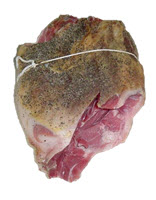The Secret to Cooking Country Ham
I can remember cooking the first couple of hams for some people in the neighborhood back in 1975. It was for the Thanksgiving, and I had a few turkeys to prepare too.
At that time we didn’t have a kitchen in the back room yet. So I 
While that worked great (for one or 2 maybe 3 hams), it tied up my only oven for a long time. By Christmas the orders started to get larger and more people were wanting the hams cooked, boned and sliced (CBS). That first year of doing that was pretty crazy!
Next year I built a kitchen with commercial ovens, and actually started do subs, lunch menu and rotisserie chicken. Now, you talk  about “jumping out of the skillet and into the fire”, that was nuts, but continued for a year maybe two. Then I said good-bye to that for a couple of reason we will not get into.
about “jumping out of the skillet and into the fire”, that was nuts, but continued for a year maybe two. Then I said good-bye to that for a couple of reason we will not get into.
Rotisserie Chicken NO More…
What to do with the rotisserie was a challenge, but soon decided to donate it the the church. However, before I did, I thought what if I boned the country ham and skewered them and put them in the rotisserie?
WOW, Great Country Ham
The country ham turned out fantastic! WHSV video taped the hams turning around for a TV commercial I was doing, and it really looked good. BUT…what a mess it made.
I gave away the rotisserie! I also kept boning the hams tough, soaking over night and cooking them in the oven the next morning. THAT was a GREAT idea. I could cook three times the amount of ham each day and eliminate the mess afterwards that you would normally have – (handling hot ham, de-boning, cutting away the hot excess fat, grease all over the place)…!@#$%
More Country Hams – In Less The Time
Now you have my “Country Ham Secret”! You see, but removing the  bone and trimming prior to soaking and cooking the hams solved a couple problems with cooking country ham-
bone and trimming prior to soaking and cooking the hams solved a couple problems with cooking country ham-
- cooking time – cooked more hams in less the time
- messy cleanup – handling hot ham ad clean up
- moister and better flavor
Recipe – Country Ham
- Remove bone and trim outside skin and yellow fat
- soak for 2-3 hours in warm water to loosen salt cure
- change water and soak over-night
- place in pan with 1# of water
- 450 degree oven for approximate 2-1/2 – 3 hours. or inside temperature of 160 degrees
- take out cool, wrapped in film and refrigerate 9 (keeps for weeks not sliced and wrapped)
Pretty simple huh!
Have a ham sandwich! Yum!

